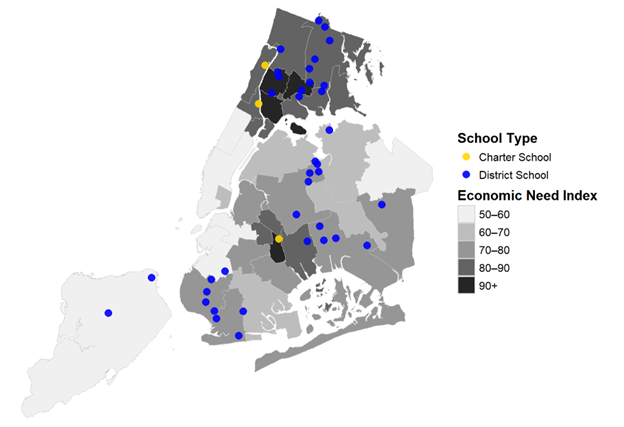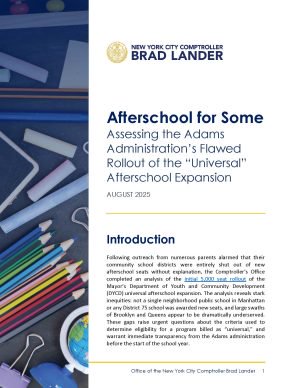Introduction
Following outreach from numerous parents alarmed that their community school districts were entirely shut out of new afterschool seats without explanation, the Comptroller’s Office completed an analysis of the initial 5,000 seat rollout of the Mayor’s Department of Youth and Community Development (DYCD) universal afterschool expansion. The analysis reveals stark inequities: not a single neighborhood public school in Manhattan or any District 75 school was awarded new seats, and large swaths of Brooklyn and Queens appear to be dramatically underserved. These gaps raise urgent questions about the criteria used to determine eligibility for a program billed as “universal,” and warrant immediate transparency from the Adams administration before the start of the school year.
Data Analysis and Findings
Geographic analysis and mapping of the 40 schools[1] selected for the City’s 5,000 seat rollout was conducted using 2023-2024 demographic data reported by the Department of Education[2] and ArcGIS. Those data are represented in Map 1. As reported previously in the recent Comptroller’s Office report Stranded After School, survey data was drawn from a spring 2025 survey of more than 600 New York City public and charter school principals on their afterschool programs.[3]
Key Findings
District 75
- Despite already facing severe inequities in afterschool access—documented in the Stranded After School report, which found no surveyed District 75 programs had access to the DYCD funding that underpins much of the afterschool programming in the City—no District 75 schools received any of the newly allocated afterschool seats.
Queens
- Ten of the 12 selected schools are in Districts 24 and 27 with a concentration of seats in Corona and North Corona.
- No seats were awarded in Districts 28 or 30 excluding all of western Queens and schools in Astoria, Sunnyside, Woodside, East Elmhurst, Jackson Heights, Richmond Hill and most of Jamaica.
- In District 30, both PS 171 and PS 76—serving NYCHA families in Astoria, Queensbridge, and Ravenswood Houses—lost state afterschool funding this past year and were excluded.[4]
Brooklyn
- Seven of 10 selected schools are concentrated in South Brooklyn Districts 20, 21, and 22 including Dyker Heights, Bensonhurst and Gravesend.
- Multiple high-need districts, as measured by DOE’s Economic Need Index (ENI), received few or no seats. Across Crown Heights, Bedford-Stuyvesant, Brownsville, East New York, and Bushwick, only one public school and one charter school were awarded new seats.
Manhattan
- No new afterschool seats were awarded to neighborhood public schools.
- Only two schools in the entire borough were selected for seats—both charter schools.
- According to survey data, schools in upper Manhattan have afterschool waitlists with dozens of children awaiting a seat and at least one Harlem public elementary school has no current afterschool program due to lost funding under the State’s LEAPS initiative was excluded.
Map 1: Afterschool Rollout Locations and District Economic Need Index

Source: New York City Department of Education and Comptroller’s Office Analysis
Recommendations
To ensure transparency and equity in the allocation of new afterschool seats, the City should:
- Immediately allocate additional seats in the 2025-26 school year to address the disparities identified in this report.
- Commit to equitably prioritizing high-needs communities in all future allocations, using ENI, STH, and NYCHA data as guiding factors, and make public the specific criteria and data used to determine which schools receive seats in all future rollouts.
- Directly engage with key stakeholders in future rollouts, including but not limited to school district leadership, principals, teachers, parents, and students to ensure the additional seats meet the needs of local school districts.
This administration’s commitment to expanding critically important afterschool programs is commendable. But to ensure equity and transparency, the City’s seat selection process must be clear and give all high-need schools a fair opportunity to receive seats this fall and in future rollouts.
Endnotes
[1] https://www.nyc.gov/site/dycd/services/after-school/compass-expansion.page
[2] https://infohub.nyced.org/reports/students-and-schools/school-quality/information-and-data-overview
[3] https://comptroller.nyc.gov/reports/stranded-after-school/
[4] https://astoriapost.com/op-ed-new-yorks-afterschool-crisis-restore-the-programs-families-rely-on
